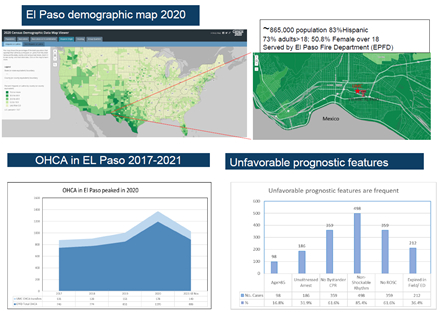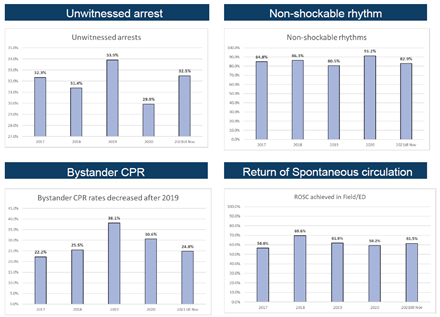Final ID: Su908
Unfavorable prognostic features and temporal trends in Out-of-Hospital Cardiac Arrests (OHCA) presenting to an Academic Center at the Border in El Paso
Abstract Body: Introduction: Early recognition of cardiac arrest with bystander cardiopulmonary resuscitation (CPR), and early defibrillation when appropriate, can improve outcomes after Out of Hospital Cardiac Arrest (OHCA). Data from the national registries indicate there are both regional as well racial and ethnic differences in rates of bystander CPR in witnessed OHCA cases with significantly lower rates of bystander CPR in non-white persons. However, Hispanic as well border populations are underrepresented in these studies. University Medical Center (UMC) El Paso, Texas is an academic medical center located 1 mile from the US- Mexico border which is also the only not for profit safety net hospital with a Level1 trauma center.
Research question: Outcomes after OHCA are strongly affected by peri-arrest circumstances including bystander CPR and certain features portend poor outcomes. We performed a descriptive observational study of OHCA cases presenting to UMC to analyze temporal trends in these factors in our community as local data from El Paso is currently not reported in any registries.
Methods: We collaborated with the El Paso Fire Department (EPFD) to obtain resuscitation data on patients who suffered OHCA and were brought to the University Medical Center (UMC)Emergency Department (ED) and created a registry of patients who suffered OHCA in El Paso FROM 2017 to Nov 2021.
Results: Initial analysis identified around 698 predominantly Hispanic patients who suffered OHCA. Of these 115 were due to non-cardiac causes such as trauma, and 583 were possible cardiac etiology. OHCA cases peaked in 2020 coinciding with COVID 19 surge. Less than one third (31.5%) had bystander CPR with only 11.9% having a shockable rhythm. 64% did not achieve Return of spontaneous circulation in the field. 39% expired in the ED or in the field. We also performed a temporal analysis of these features and bystander CPR rates peaked in 2019 (38.1%to 24.8% in 2021).
Conclusion: In our Hispanic underserved population in El Paso, we identified poor outcomes after OHCA, with non-shockable rhythm being the most common adverse feature and decreased rates of bystander CPR (31.5%) with further decrease after 2019. Local community level data which is critical for appropriate local resource allocation to improve OHCA outcomes is missing from underserved populations and additional resources are required improve outcomes.
Research question: Outcomes after OHCA are strongly affected by peri-arrest circumstances including bystander CPR and certain features portend poor outcomes. We performed a descriptive observational study of OHCA cases presenting to UMC to analyze temporal trends in these factors in our community as local data from El Paso is currently not reported in any registries.
Methods: We collaborated with the El Paso Fire Department (EPFD) to obtain resuscitation data on patients who suffered OHCA and were brought to the University Medical Center (UMC)Emergency Department (ED) and created a registry of patients who suffered OHCA in El Paso FROM 2017 to Nov 2021.
Results: Initial analysis identified around 698 predominantly Hispanic patients who suffered OHCA. Of these 115 were due to non-cardiac causes such as trauma, and 583 were possible cardiac etiology. OHCA cases peaked in 2020 coinciding with COVID 19 surge. Less than one third (31.5%) had bystander CPR with only 11.9% having a shockable rhythm. 64% did not achieve Return of spontaneous circulation in the field. 39% expired in the ED or in the field. We also performed a temporal analysis of these features and bystander CPR rates peaked in 2019 (38.1%to 24.8% in 2021).
Conclusion: In our Hispanic underserved population in El Paso, we identified poor outcomes after OHCA, with non-shockable rhythm being the most common adverse feature and decreased rates of bystander CPR (31.5%) with further decrease after 2019. Local community level data which is critical for appropriate local resource allocation to improve OHCA outcomes is missing from underserved populations and additional resources are required improve outcomes.
More abstracts on this topic:
A Case of Successful Resuscitation After Out-of-hospital Cardiac Arrest Caused by Undiagnosed Pheochromocytoma-induced Cardiomyopathy
Hatakeyama Toshihiro, Suetsugu Yusuke, Watanabe Kaoru, Matsushima Hisao
A Comparative Analysis of Social Demographic and Clinical Factors for Screening for Peripheral Artery Disease in Adult Patients from Primary Care ClinicsLane Rashon, Jackson Pasha, Anokwuru Ferdinand, Dillard Naomi, Nerlekar Ridhima


